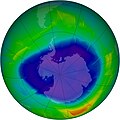Податотека:2009 Antarctic Ozone Hole (3927062424).jpg

Големина на овој преглед: 600 × 600 пиксели. Други разделности: 240 × 240 пиксели | 480 × 480 пиксели | 716 × 716 пиксели.
Изворна податотека (716 × 716 пиксели, големина: 283 КБ, MIME-тип: image/jpeg)
Историја на податотеката
Стиснете на датум/време за да ја видите податотеката како изгледала тогаш.
| Датум/време | Минијатура | Димензии | Корисник | Коментар | |
|---|---|---|---|---|---|
| тековна | 03:28, 12 мај 2018 |  | 716 × 716 (283 КБ) | OceanAtoll | Transferred from Flickr via #flickr2commons |
Употреба на податотеката
Нема страници што ја користат оваа податотека.
Глобална употреба на податотеката
Оваа податотека ја користат и следниве викија:
- Употреба на de.wikibooks.org
- Употреба на en.wikibooks.org
